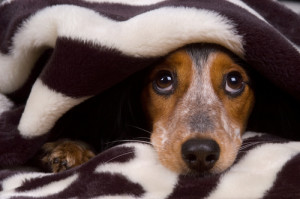SHARE this!
Dogs develop fears throughout their lives. Seemingly harmless events during the formative puppy stages could plague a happy go lucky dog throughout their life. Dogs also pick up on and exhibit fears of their owners. They watch how the pack leaders react to certain situations and will become fearful themselves over something as harmless as a broom falling over. Below are five common phobias dogs face and how to work with them.
1. Loud Noises (Thunderstorms, Fireworks, Vacuuming, Etc.)
A thunderstorm rolls in and owners scoop up their dogs trying to soothe them into a calm state. What this actually is doing is encouraging the panic. A dog getting patted and cooed over, is receiving praise for being in a fear state. Which will encourage the dog, who will assume this is the response he is suppose to have to all loud noises. There are a couple of ways to break the cycle. One is to stop the coddling. The dog needs to learn this is not the appropriate response to have. The owner should remain calm and detached, showing no signs of fear or reaction themselves. Try to redirect the dogs fear in a positive manner. During a loud noise event feed them a high end treat, something they don’t get very often. Play a new game that will get the dogs mind thinking the loud noises aren’t so bad.
2. Separation anxiety
Separation anxiety runs the gamut from quiet whining to utter destruction. There have been such severe cases of dogs chewing through walls, breaking down doors with their head causing bodily injury and leaping off balconies because they don’t like being away from their owners. With some of the milder cases, separation anxiety can be eased by exercising the dog before an owner has to leave. For example, 10 minutes of fetch in the backyard or a brisk 20 minute walk. Leave the radio or TV on for company. Some dogs like to hear voices, others calming music whatever is best for the dog. For moderate to severe cases, seek out a qualified (certified) dog trainer, one that is experienced in dealing with behavioral issues.
Related: 10 Best Dog Doors
3. Car Rides
The most common link to a car ride phobia is that the destination is unpleasant. If the dog only goes into the car to go to the vet, there will be anxiety of not wanting to get in the car. For a rescue dog, there is the fear that getting in the car will end in being separated from their pack, again. To alleviate this fear, or at least ease it a bit, make car outings a positive experience. Put a soft comfy blanket down to rest, give some treats and make the destination a positive place, like the dog park or someplace the dog likes to be.
4. Hats & Sunglasses
Dogs are incredible people decoders. If a dog doesn’t like someone, there must be a reason why. One of the things dogs appreciate is seeing who they’re dealing with. Someone approaching with a hat and sunglasses are not to be trusted and some dogs will take offense by barking, lunging and nipping. If the “hidden” person is expecting to interact with the dog, it is up to the owner to explain and ask for the person to remove both hat and sunglasses. Most of the time the dog will, albeit hesitantly, calm himself enough to decide whether they want to interact with the person or not.
5. Children
Whether or not the dog had a negative experience in the past concerning a child, there are some dogs who just don’t like children, period. There are certain training methods that can be used to make a dog more tolerant of children, but trying to turn an ambivalent dog into a happy family dog wouldn’t be good for the dog or the owners. This particular issue is one that should be discussed and worked on with an experienced dog trainer.
SHARE this!



Comments are closed.